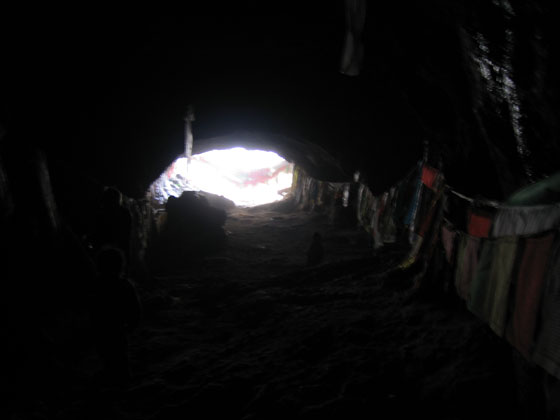After Xi?an I headed West again. Another sleeper train took me to Lanzhou, the largest city in the Gansu Province, where I immediately caught a six hour bus to a small mountain town called Xiahe. The town has a large Tibetan influence because of the Buddhist Temple founded there which has a famous pilgrim?s walk of prayer wheels and stupas. The town?s population includes 1,000 monks, Tibetan nomads, Chinese Muslims and Han Chinese. The weather had been getting colder since leaving Beijing and I was able to pick up a jacket in Xi?an but I was unprepared for a few days at 3,000 meters. Mornings were 30 degrees feirenheight and afternoons only reached into the 50?s.
The town was quite small but it did have a modern section where the Han lived. Every day the townspeople walked around town wearing long sheepskin coats, guiding yaks and donkeys. The woman wear their hair in two braids fastened at the bottom, a lot like Peruvian woman around Lake Titticaca. Mixed in with the traditional townspeople were monks with shaven heads and long maroon and dark pink robes. Interestingly, the monks acted like anyone else in town, talking on cell phones and watching TV in restaurants. While I was drawing at the large temple a monk took great interest and invited me back to his living quarters. We ate bread and drank a strange salty tea and saw his English lessons and sketchbook. When I asked who he talked to on his phone he told me that he talks to his monk friends in town. I also figures out why men?s pinky fingernails are so long–the better to clean their ears.
Another day a few people I had met and I rented a minibus to take us out into the grasslands and more traditional villages. We stopped at one monastery that turned out to be a big cave surrounded by prayer flags. None of the monks or pilgrims spoke English so we blindly walked into the pitch black cave. We would stop, thinking we were at the end until we saw a flicker of a candle or heard voices. The path got increasingly slippery and narrow until we came upon a small opening. We all decided that we wouldn?t go in until a young monk came along and dragged me into the opening. The others stayed behind and I found myself in complete darkness following a monk through mud-covered tunnels and climbing up large walls of rocks into the darkness–not knowing if I would hit my head or drop 14 feet. After every new opening I told the monk I didn?t want to go in Chinese. He would insist that I follow him. After what seemed like a long time with no carvings or light in sight I started to get worried. He was even more insistent that I go on and I broke down saying ?I don?t understand? and ?I don?t want to? in Chinese–the only phrases I knew. After a small panic attack I heard the voices of the the others and I had apparently gone full-circle. There were no carvings or statues in the cave–only mud and a lot of slippery rocks. We could only assume it was another pilgrim?s path that had some spiritual meaning. I emerged with only a few scrapes on my hands and covered in a lot of mud. Below is a picture of the cave opening.

One response to “Not Quite Tibet”
Girl,
You are crazy. Always putting yourself in crazy situations. At least you have good stories and you came out okay. Watch out for bugs.